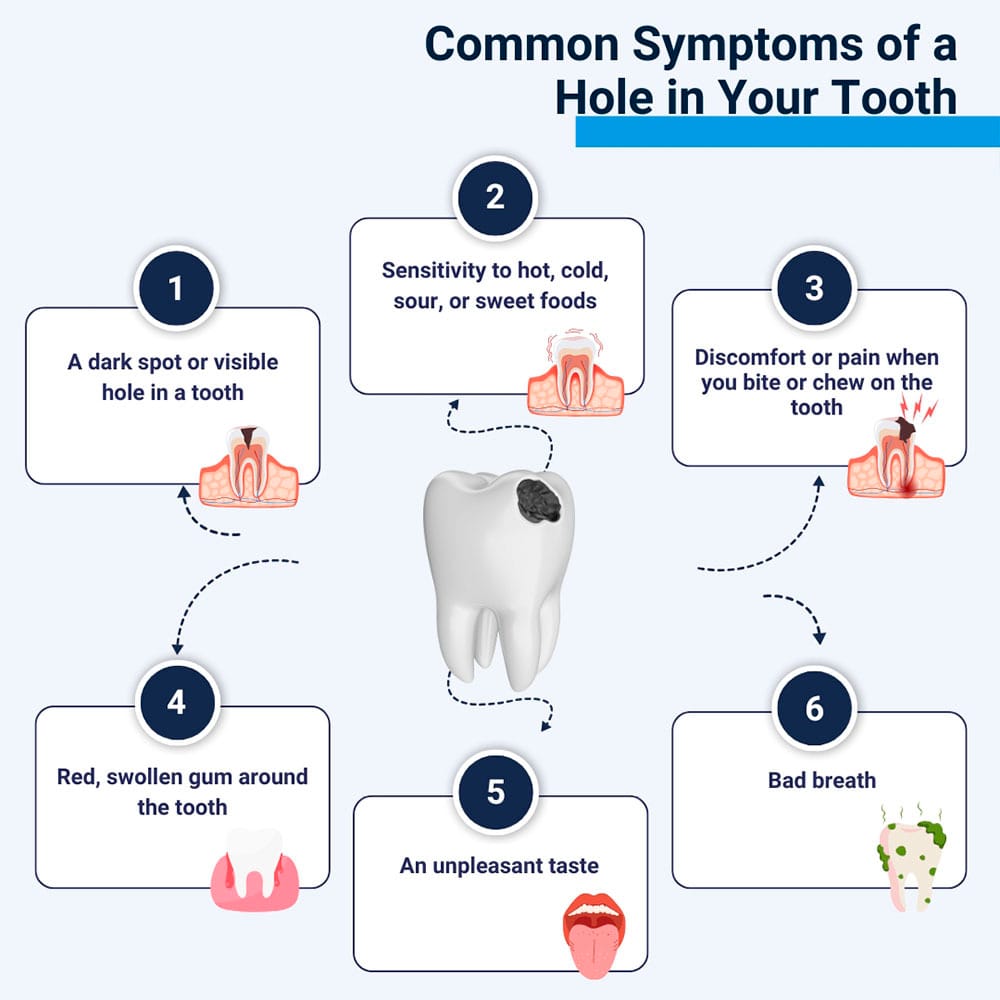How Does a Hole in a Tooth Develop?
A hole or cavity can start to develop when tooth enamel becomes eroded. Although tooth enamel is tough, it gradually weakens when exposed to acids, eventually creating a hole. These acids can be found in certain foods and beverages but are most often produced by bacteria in dental plaque.
Once a hole has begun forming in tooth enamel, bacteria can begin destroying the dentin underneath, which is much softer. While the hole may look relatively small, it could conceal a larger cavity in a tooth.
What are the Symptoms of a Hole in a Tooth?
Signs that you may have a cavity can include:
- A dark spot or visible hole in a tooth.
- Sensitivity to hot, cold, sour, or sweet foods.
- Discomfort or pain when you bite or chew on the tooth.
- Red, swollen gum around the tooth.
- An unpleasant taste.
- Bad breath.
If you notice any of these signs, we suggest you visit us at Clock Tower Dental. An untreated hole or cavity in a tooth will gradually deepen until it reaches the dental pulp.
At this stage, you are likely to experience severe toothache. There is a risk the infection could develop into a dental abscess. A dental abscess can be serious and require emergency dental care.

Diagnosing a Cavity
We can quickly diagnose problems like cavities by visually examining your teeth and testing tooth surfaces for weak spots or lesions in tooth enamel.
If we find a cavity, we will want to take a digital dental X-ray. The X-rays are essential because they show us what’s going on beneath the tooth’s surface and allow us to see the size of the cavity and plan your treatment.
Treating a Hole in Your Tooth
We can treat tooth decay in various ways depending on the size of the damage or cavity.
Small Lesions or Soft Spots in Tooth Enamel
If you merely have a small lesion in a tooth and where the hole hasn’t penetrated the tooth enamel, we may be able to re-harden the enamel with an application of professional strength fluoride. The fluoride helps restore minerals removed by acids, strengthening the tooth enamel and increasing its resistance to decay.
Small or Medium-Sized Cavities
Small or medium-sized cavities can be mended with tooth-colored composite resin. These fillings are placed chairside and are completed in a single visit.
Larger Cavities in Back Teeth
If you have a larger cavity in a back tooth, we may suggest an inlay or onlay. These restorations are made from porcelain or gold, are durable and strong, and should last many years.
Infected Dental Pulp
An infection that has reached your dental pulp will require root canal therapy. Treatment isn’t any worse than an ordinary filling, but it will take longer. After removing the dental pulp and all the other decaying tissues, we seal the tooth with gutta-percha.
Usually, it’s necessary to cover the tooth entirely with a dental crown since the cavity is almost certainly quite large.
Tooth Extraction
Tooth removal is always the last resort; we will only suggest this if there is no other option. It may be necessary if you have developed a dental abscess and where we must extract the tooth to allow the infection to drain.
Preventing Cavities
Tooth decay is a preventable condition. Practicing good oral hygiene, including regular brushing and flossing, removes most harmful plaque, making your teeth less likely to be exposed to acids.
Some tips to follow include:
- Brush your teeth at least twice daily with fluoride toothpaste, and use a soft-bristled brush that will not damage your tooth enamel.
- Floss daily as only flossing can eliminate plaque and food between your teeth.
- Watch your consumption of sugary foods and beverages. If you have these items, consume them as part of your main meal.
- Drink plenty of water to help wash away excess bacteria and loose food particles.
- Schedule regular dental checkups. Most people need to see us twice a year, but we may suggest more frequent checkups as part of our general dentistry services if oral or medical issues make you more prone to cavities.
Are You Concerned You May Have a Cavity?
Get in touch with us to schedule your appointment. Tooth decay isn’t usually serious when treated promptly, but a cavity will continue to worsen without treatment. It cannot get better without professional dental care from Clock Tower Dental.

